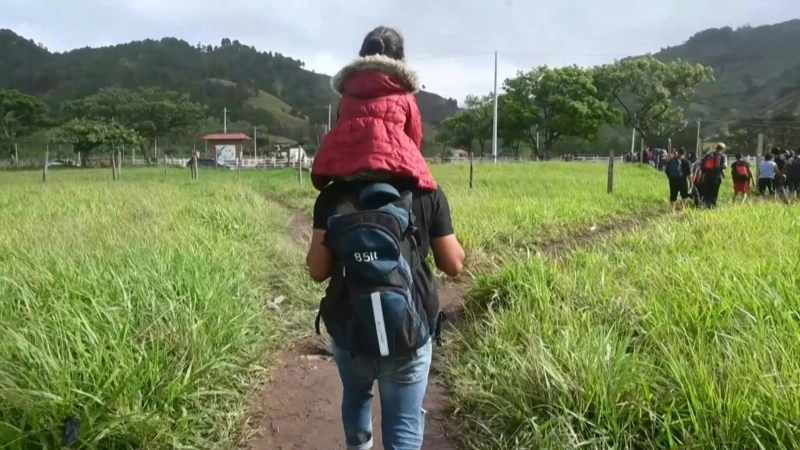Cuban Diana Guzmán arrived with her family in Honduras after a risky journey by land from South America, like many of her compatriots. She was robbed of everything in the jungle and she asks for help to follow her migration to the United States.
In the speakers of a business in Comayagüela, neighboring the capital Tegucigalpa, tropical rhythms sound. Diana, 48, dances with her granddaughter Brianna, 6. She carries candy that she bought to resell to passers-by. On one side of her, her sister (54), her daughter (32) and her son-in-law (34) observe them. They go through trouble but keep the joy.
This group is one more example of a change in trend in migration that uses Central America to try to reach the United States.
In 2021, Honduras registered the passage of 17,590 migrants in an irregular situation, mainly Haitians. But the situation changed in 2022. Between January and the beginning of June they have exceeded 44,000 and the majority come from Cuba, a nation overwhelmed by a severe economic crisis. Venezuelans follow.
A nursing home worker, Diana and her family sold the two houses they had in Cuba and bought tickets to Guyana for $1,500 a ticket.
They began their journey three months ago and continued by land to Brazil, Peru, Ecuador and Colombia, until entering the Darién jungle, famous for the danger it represents for those who try to cross it.
“The journey has been quite hard because when we entered the jungle we didn’t think we were going to go through the work we did. The jungle between Panama and Colombia, they robbed us there,” says Diana.
He says that they were abandoned naked and tied up in the jungle.
“They took everything from us, they trampled on the food we brought. They took the phones from us. They were dressed in black, with shotguns, and whoever objected or said something (…) they hit him with the shotgun and left them lying there” , Explain.
Hours later, other migrants found them, untied them and gave them clothes and food. An indigenous community in Panama supported them.
“There in the jungle you walk and people fall in front of you, and when you come to see they are already dead. The jungle is very hard and I would never want to go through that again,” Diana details.
According to the Panamanian authorities, Haitians led the way through this jungle in 2021. So far this year, Venezuelans and Cubans lead the list.
Discretion in Managua
Since Nicaragua does not require a visa from Cubans, many prefer to fly to Managua to continue north. The high demand from Havana has placed the tickets at around 6,000 dollars, according to the users themselves.
Migrants in Managua who prefer anonymity say that they leave the island with the agreed “tour”: lodging in Nicaragua that goes from 15 to 30 dollars a night and transfer by “facilitators.” The trips are financed by their relatives in the United States.
But others like Diana do not have the same luck and travel to South America and then go up.
After crossing Nicaragua, they arrive by bus at the town of El Porvenir, on the border with Honduras.
They walk along the edge of a cornfield, cross a eucalyptus forest and appear in Honduras.
There, motorcycle taxis await them to transport them to Trojes, a city of some 54,000 inhabitants with cement streets between green mountains.
In the center of Trojes, they crowd in front of the office of the National Directorate of Migration, where they have to pay a $210 fine for irregular entry.
Those who cannot pay stay for several days until the authorities give them a pass to continue. The next stop is Danlí and then Tegucigalpa or Comayagüela.
Controls in Guatemala
Unlike other migrants, several Cubans who arrive in the United States can turn themselves in to the authorities, enter on parole and try to take advantage of the Cuban Adjustment Act (1966), a benefit that dates back to the Cold War and allows those who leave Cuba to apply for legal residency in the United States. Others ask for asylum.
“I am coming for the economic situation we have in Cuba, which is quite bad. The salary was barely enough for us, if we bought a pair of flip-flops (sandals), we could not eat,” laments Diana.
“We don’t have anyone to send us money from abroad and we decided to come to give a better future to the family that is in Cuba, and to my granddaughter,” she adds.
In Comayagüela, migrants board public transport buses heading to the border with Guatemala. Some make the journey on their own and others rely on human traffickers known as “coyotes.”
On Wednesday the 15th, the Guatemalan authorities, who have reinforced controls on their highways, captured eight “coyotes” and intercepted the passage of almost a hundred migrants, most of them from Cuba and Venezuela.
As he prepares to continue his journey from Honduras, Yasmani Alsina, Diana’s son-in-law, trusts in the good will of the Central Americans.
“Please help all the immigrants, they don’t know what they’ve been through in the jungle, it’s not a story (…) we need them to reach our destinations and have a better future.”
Connect with the Voice of America! Subscribe to our channel Youtube and turn on notifications, or follow us on social media: Facebook, Twitter and Instagram.








![[Img #74675]](https://thelatestnews.world/wp-content/uploads/2024/12/They-discover-a-new-class-of-X-ray-sources-in-the-150x150.jpg)






Add Comment